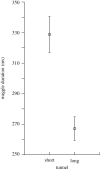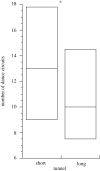Optic flow informs distance but not profitability for honeybees
- PMID: 20018787
- PMCID: PMC2842809
- DOI: 10.1098/rspb.2009.1802
Optic flow informs distance but not profitability for honeybees
Abstract
How do flying insects monitor foraging efficiency? Honeybees (Apis mellifera) use optic flow information as an odometer to estimate distance travelled, but here we tested whether optic flow informs estimation of foraging costs also. Bees were trained to feeders in flight tunnels such that bees experienced the greatest optic flow en route to the feeder closest to the hive. Analyses of dance communication showed that, as expected, bees indicated the close feeder as being further, but they also indicated this feeder as the more profitable, and preferentially visited this feeder when given a choice. We show that honeybee estimates of foraging cost are not reliant on optic flow information. Rather, bees can assess distance and profitability independently and signal these aspects as separate elements of their dances. The optic flow signal is sensitive to the nature of the environment travelled by the bee, and is therefore not a good index of flight energetic costs, but it provides a good indication of distance travelled for purpose of navigation and communication, as long as the dancer and recruit travel similar routes. This study suggests an adaptive dual processing system in honeybees for communicating and navigating distance flown and for evaluating its energetic costs.
Figures




Similar articles
-
Going with the flow: a brief history of the study of the honeybee's navigational 'odometer'.J Comp Physiol A Neuroethol Sens Neural Behav Physiol. 2014 Jun;200(6):563-73. doi: 10.1007/s00359-014-0902-6. Epub 2014 Apr 17. J Comp Physiol A Neuroethol Sens Neural Behav Physiol. 2014. PMID: 24740382 Review.
-
Two odometers in honeybees?J Exp Biol. 2008 Oct;211(Pt 20):3281-6. doi: 10.1242/jeb.021022. J Exp Biol. 2008. PMID: 18840662
-
Honeybee navigation: nature and calibration of the "odometer".Science. 2000 Feb 4;287(5454):851-3. doi: 10.1126/science.287.5454.851. Science. 2000. PMID: 10657298
-
A stingless bee (Melipona seminigra) uses optic flow to estimate flight distances.J Comp Physiol A Neuroethol Sens Neural Behav Physiol. 2003 Oct;189(10):761-8. doi: 10.1007/s00359-003-0448-5. Epub 2003 Aug 19. J Comp Physiol A Neuroethol Sens Neural Behav Physiol. 2003. PMID: 12928953
-
Honeybees as a model for the study of visually guided flight, navigation, and biologically inspired robotics.Physiol Rev. 2011 Apr;91(2):413-60. doi: 10.1152/physrev.00005.2010. Physiol Rev. 2011. PMID: 21527730 Review.
Cited by
-
A plea for academic decency.J Comp Physiol A Neuroethol Sens Neural Behav Physiol. 2025 Jun 13. doi: 10.1007/s00359-025-01745-6. Online ahead of print. J Comp Physiol A Neuroethol Sens Neural Behav Physiol. 2025. PMID: 40514457
-
A Sublethal Concentration of Sulfoxaflor Has Minimal Impact on Buff-Tailed Bumblebee (Bombus terrestris) Locomotor Behaviour under Aversive Conditioning.Toxics. 2023 Mar 18;11(3):279. doi: 10.3390/toxics11030279. Toxics. 2023. PMID: 36977044 Free PMC article.
-
Landmark knowledge overrides optic flow in honeybee waggle dance distance estimation.J Exp Biol. 2024 Nov 1;227(21):jeb248162. doi: 10.1242/jeb.248162. Epub 2024 Oct 23. J Exp Biol. 2024. PMID: 39319438 Free PMC article.
-
Network analysis of rat spatial cognition: behaviorally-established symmetry in a physically asymmetrical environment.PLoS One. 2012;7(7):e40760. doi: 10.1371/journal.pone.0040760. Epub 2012 Jul 18. PLoS One. 2012. PMID: 22815808 Free PMC article.
-
Going with the flow: a brief history of the study of the honeybee's navigational 'odometer'.J Comp Physiol A Neuroethol Sens Neural Behav Physiol. 2014 Jun;200(6):563-73. doi: 10.1007/s00359-014-0902-6. Epub 2014 Apr 17. J Comp Physiol A Neuroethol Sens Neural Behav Physiol. 2014. PMID: 24740382 Review.
References
-
- Barron A., Srinivasan M. V.2006Visual regulation of ground speed and headwind compensation in freely flying honeybees (Apis mellifera L.). J. Exp. Biol. 209, 978–984 (doi:10.1242/jeb.02085) - DOI - PubMed
-
- Barron A. B., Zhu H., Robinson G. E., Srinivasan M. V.2005Influence of flight time and flight environment on distance communication by dancing honey bees. Insect. Soc. 52, 402–407 (doi:10.1007/s00040-005-0827-8) - DOI
-
- Dacke M., Srinivasan M. V.2008Two odometers in honeybees? J. Exp. Biol. 211, 3281–3286 (doi:10.1242/jeb.021022) - DOI - PubMed
-
- Dyer F. C.2002The biology of the dance language. Annu. Rev. Entomol. 47, 917–949 (doi:10.1146/annurev.ento.47.091201.145306) - DOI - PubMed
-
- Esch H. E., Burns J. E.1995Honeybees use optic flow to measure the distance of a food source. Naturwissenschaften 82, 38–40 (doi:10.1007/BF01167870) - DOI
MeSH terms
LinkOut - more resources
Full Text Sources
Research Materials
Miscellaneous

